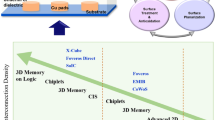Abstract
In this paper a new operational amplifier is presented which is based on the conventional folded cascode Op-Amp structure. A new method of positive feedback is used to increase dc-gain. This method does not limit the range of the output voltage swing. True performance of the Op-Amp in higher output voltage swings is another advantage of the proposed Op-Amp in comparison with the conventional structures. Bulk amplification and positive feedback are used to improve the Op-Amp specifications. Proposed structure has been simulated by HSPICE software using level 49 parameters (BSIM3v3) in a typical 0.35 μm CMOS technology. The HSPICE simulation confirms the theoretical estimated improvements.













Similar content being viewed by others
References
Gulati, K., & Lee, H.-S. (1998). A high-swing CMOS telescopic operational amplifier. IEEE J Solid-State Circuits, 33(12), 2010–2019.
Nakamura, K., & Richard Carley, L. (1992). An enhanced fully differential folded-cascode Op-Amp. IEEE Journal of Solid-State Circuits, 27(4), 563–568.
Musah, T., Gregoire, B. R., Naviasky, E., & Moon, U. (2007). Parallel correlated double sampling technique for pipelined analogue-to-digital converters. Electron Letter, 43(23), 1260–1261.
Gregoire, B. R., & Moon, U. (2008). An over-60 dB true rail-to-rail performance using correlated level shifting and an opamp with only 30 dB loop gain. IEEE Journal of Soild-State Circuits, 43(12), 2620–2630.
Laber, C. A., & Gray, P. R. (1988). A positive-feedback transconductance amplifier with applications to high-frequency, high-Q CMOS switched-capacitor filters. IEEE Journal of Solid-State Circuits, 23(6), 1370–1378.
Ramirez-Angulo, J., Calvo, B., Carvajal, R., Lopez-Martin, A. (2010) Low-voltage gm-enhanced CMOS differential pairs using positive feedback (pp. 773–776). Paris, France: IEEE ISCAS
Razavi, B. (2001). Design of analog CMOS integrated circuits. McGraw-Hill.
Gray, P. R., Hurst, P. J., Lewis, S. H., & Meyer, R. G. (2001). Analysis and design of analog integrated circuits. New York: Wiley.
Mottaghi-Kashtiban, M., Hadidi, Kh., & Khoei, A. (2006). Modified CMOS Op-Amp with improved gain and bandwidth. IEICE Transactions on Electron, E89–C, 775–780.
Zhang, M. M., & Hurst, P. J., (2006) Effect of nonlinearity in the CMFB circuit that uses the differential-difference amplifier. IEEE International Symposium on Circuits and Systems, 1390–1393.
Guzinski, A., Bialko, M., & Matheau, J. C. (1987). Body driven differential amplifier for application in continuous-time active C-filter (pp. 315–319). Paris, France: Proc.ECCD.
Blalock, B. J., et al., (1998). Designing 1-V op amps using standard digital cmos technology. Circuits and Systems II: Analog and Digital Signal Processing, 45, 769–780.
Acknowledgment
The authors are grateful to reviewers for their valuable comments.
Author information
Authors and Affiliations
Corresponding author
Rights and permissions
About this article
Cite this article
Dadashi, A., Sadrafshari, S., Hadidi, K. et al. An enhanced folded cascode Op-Amp using positive feedback and bulk amplification in 0.35 μm CMOS process. Analog Integr Circ Sig Process 67, 213–222 (2011). https://doi.org/10.1007/s10470-010-9561-x
Received:
Revised:
Accepted:
Published:
Issue Date:
DOI: https://doi.org/10.1007/s10470-010-9561-x




